Insights into depolymerization pathways and mechanism of alkali lignin over a Ni1.2-ZrO2/WO3/γ-Al2O3 catalyst
Xinyu Lu,Dandan Wang,Haoquan Guo,Pengcheng Xiu,Jiajia Chen,Yu Qin,Hossain Mahmud Robin,Chaozhong Xu,Xingguang Zhang,Xiaoli Gu,*
1 Co-Innovation Center for Efficient Processing and Utilization of Forest Products,College of Chemical Engineering,Nanjing Forestry University,Nanjing 210037,China
2 Department of Chemistry,School of Science,University of Shanghai for Science and Technology,Shanghai 200093,China
Keywords:Alkali lignin Formic acid Chemical reduction Phenolic compounds
ABSTRACT This study performed catalytic depolymerization of alkali lignin over Ni-based catalysts.Effects of different promoters (Zr and W),Ni loadings,reaction temperatures,and the addition of formic acid and catalyst on lignin conversion and products distribution were all investigated.The result showed that the highest oil yield(40.1%(mass))was obtained at 240°C over Ni1.2/γ-Al2O3 promoted by Zr and W species.Quantitative analysis indicates that Zr and W species prefer to lignin depolymerization while Ni active phase prefer to hydrodeoxygenation and hydrogenation.The interconversion of products derived from lignin depolymerization was determined by gas chromatography-mass spectrometer,which demonstrated that phenolic compounds were dominant products in all lignin derived bio-oils,wherein the proportion of vanillin was highest (65.7%) at 180 °C,while that of alkyl guaiacols increased with the increase of temperature (from 12.45% at 180 °C to 66.67% at 240 °C).Residual lignin obtained after lignin depolymerization was also investigated for detecting differences on functional groups,wherein the disappearing peaks at 1511 cm-1 (stretching of aromatic rings),1267,1215 and 1035 cm-1(vibrations of guaiacyl and syringyl units) were detected by Fourier transform infrared spectrometry.Additionally,the higher O/C ratio measured by elemental analysis also confirmed that alkali lignin was depolymerized effectively under mild conditions.
1.Introduction
Lignocellulosic biomass,which consists of cellulose,hemicellulose and lignin,is a potential resource to produce biofuels and high-value chemicals,attracting extensive attention in scientific and industrial fields [1-4].However,lignin,a natural aromatic polymer composed of three phenylpropane units (e.g.,coniferyl,para-coumaryl and sinapyl alcohols) connected by various C-O-C (e.g.,α-O-4 and β-O-4) and C-C (e.g.,β-β and β-1) bonds,has always been regarded as a by-product existing in the black liquor during paper manufacturing [5-7].Moreover,lignin valorization depends on efficient lignin utilization,which faces many challenges owing to its complex and stubborn threedimensional amorphous structure [8,9].Huet al.[10] performed lignin depolymerization over PtRe/TiO2,Pd/C,HZSM-5,Pt/TiO2and Re/TiO2catalysts,and 18.7% (mass) of mono-phenols were obtained over PtRe/TiO2catalyst,where 4-propylsyringol was the main component accounting for 7.5% (mass).Konget al.[11]conducted the hydrogenolysis of Kraft lignin over a series of Nior Re-based catalysts,and 96.7%(mass) of bio-oil was gained over Ni-Re/Nb2O5catalyst,where 35.4% (mass) of monomers were produced with low-molecular weight.In addition,the specific depolymerization mechanism was also proposed as the function of reaction temperature,time,and H2pressure.
On the basis of the aforementioned studies,suitable depolymerization pathways promoted by heterogeneous catalysts in hydrogenolysis are more preferable compared with other conventional methods (e.g.,pyrolysis,hydrolysis and oxidation),because the heterogeneously-catalyzed hydrogenolysis obtained a higher product yield,more concentrated monomer production and efficient char inhibition [8,12-19].To date,various noble metal supported catalysts such as Rh/Al2O3,Pd/Al2O3,Ru/Al2O3,Pt/C,Pd/C,Ru/C and Rh/C have been reported to catalyze lignin depolymerization due to their outstanding performance in hydrodeoxygenation (HDO),hydrogenolysis and hydrogenation [20-23].However,the high price limits their utilization in industries.Therefore,supported non-noble metal catalysts with lower reactivity have been developed [24-26].In order to make up for the lack of hydrocraking ability of these non-noble metals,improvements in catalyst supports have become a potential way to enhance their catalytic capacity of supported non-noble metal catalystsviarising acidity/alkalinity or increasing active sites.Typically,Al2O3is widely applied as a support due to its large surface area and abundant acid sites [10,27-30].Further improvements can be achievedviathe incorporation of different oxides(e.g.,WO3,SiO2,TiO2,ZrO2and CeO2),leading to the changes in physical/chemical properties or catalyst structures (e.g.,specific surface area,active site type,and total amount of acidity),therefore,using mixed oxides as catalyst supports is an effective way to promote lignin depolymerization [28,31-36].However,most of studies mentioned above have focused on HDO of lignin model compounds such as guaiacol,eugenol,phenol and cresol,while relevant researches on the depolymerization of macromolecule lignin are insufficient.
In this study,a multi-component catalyst support(ZrO2/WO3/γ-Al2O3) was prepared by a co-impregnation method,and Ni doping was completed by chemical reduction.Lignin depolymerization was conducted in isopropanol with assistance of formic acid acting as an internal hydrogen donor.A screening research on different catalysts,including ZrO2/γ-Al2O3,WO3/γ-Al2O3,ZrO2/WO3/γ-Al2O3,and Ni1.2-ZrO2/WO3/γ-Al2O3,illustrated the excellent catalytic ability of Ni1.2-ZrO2/WO3/γ-Al2O3in hydroprocessing (including HDO,hydrogenolysis,and hydrogenation).Moreover,effects of Ni loadings,reaction temperatures,formic acid and catalyst additions,and catalyst recycling were all investigated to optimize lignin depolymerization and to record the evolution of depolymerized products.The possible reaction mechanism was proposed in Fig.1.
2.Experimental
2.1.Materials
Alkali lignin was purchased from TCI Development Co.,Ltd.(Shanghai,China) and its elemental analysis is shown in Table 1.Nickel (II) nitrate hexahydrate (Ni(NO3)2·6H2O,AR,98.0%),ammonium metatungstate hydrate ((NH4)6H2W12O40·xH2O,AR,99.5%),zirconyl chloride octahydrate(ZrOCl2·8H2O,AR,98.0%),aluminum oxide(γ-Al2O3,20 nm,AR,99.0%)were all purchased from Macklin Biochemical Co.,Ltd.(Shanghai,China).Sodium hydroxide(NaOH,AR,96.0%),hydrochloric acid (HCl,AR,38%),dichloromethane (DCM,AR,99.0%),isopropanol (HPLC,≥99.9%),formic acid (FA,AR,85.0%),ethanol (AR,95.0%;HPLC,≥99.8%),sodium borohydride (NaBH4,AR,90.0%) were all purchased from Nanjing Chemical Reagent Co.,Ltd (Nanjing,China).

Table 1 Elemental mass fraction of alkali lignin
2.2.Catalyst preparation
The support of ZrO2/WO3/γ-Al2O3was prepared to obtain Zr and W theoretical loadings of 10% (mass) (mass ratio Zr/W=1:1)by a co-impregnation method.First,required quantities of ZrOCl2·8H2O and(NH4)6H2W12O40·xH2O were dissolved in ethanol(AR)for 30 min stirring,and then γ-Al2O3was added for further stirring at 80 °C until ethanol was evaporated completely.Finally,the obtained white solid was dried at 105 °C for 12 h in an oven until constant weight,and calcined from room temperature to 600°C in air for 4 h with a fixed heating rate of 1 °C·min-1.Moreover,supports ZrO2/γ-Al2O3and WO3/γ-Al2O3were all prepared under the same conditions.
Ni-based catalysts were prepared by means of chemical reduction utilizing NaBH4as reducing agent and denoted as Nix-ZrO2/WO3/γ-Al2O3,where the subscriptxrepresented Ni loading(mmol).In a typical preparation,different amounts of Ni(NO3)2-·6H2O were dissolved in ethanol (AR) and mixed with the synthesized support with determined ratios of 0.4,0.8,1.2,and 1.6 mmol per support.After that,the mixed solution was stirred for 2 h at room temperature followed by an ultrasonic treatment to disperse substrates uniformly.Subsequently,reducing agent NaBH4(over 10 times mole of Ni loading added) was prepared as solution with deionized water,which was dropped to the mixed solution under ice water bath and stirred severely for 2 h under N2atmosphere to finish metal reduction.At last,after centrifugation for three times (washed by deionized water),the catalyst Nix-ZrO2/WO3/γ-Al2O3was obtained after being dried at 75 °C overnight under vacuum.
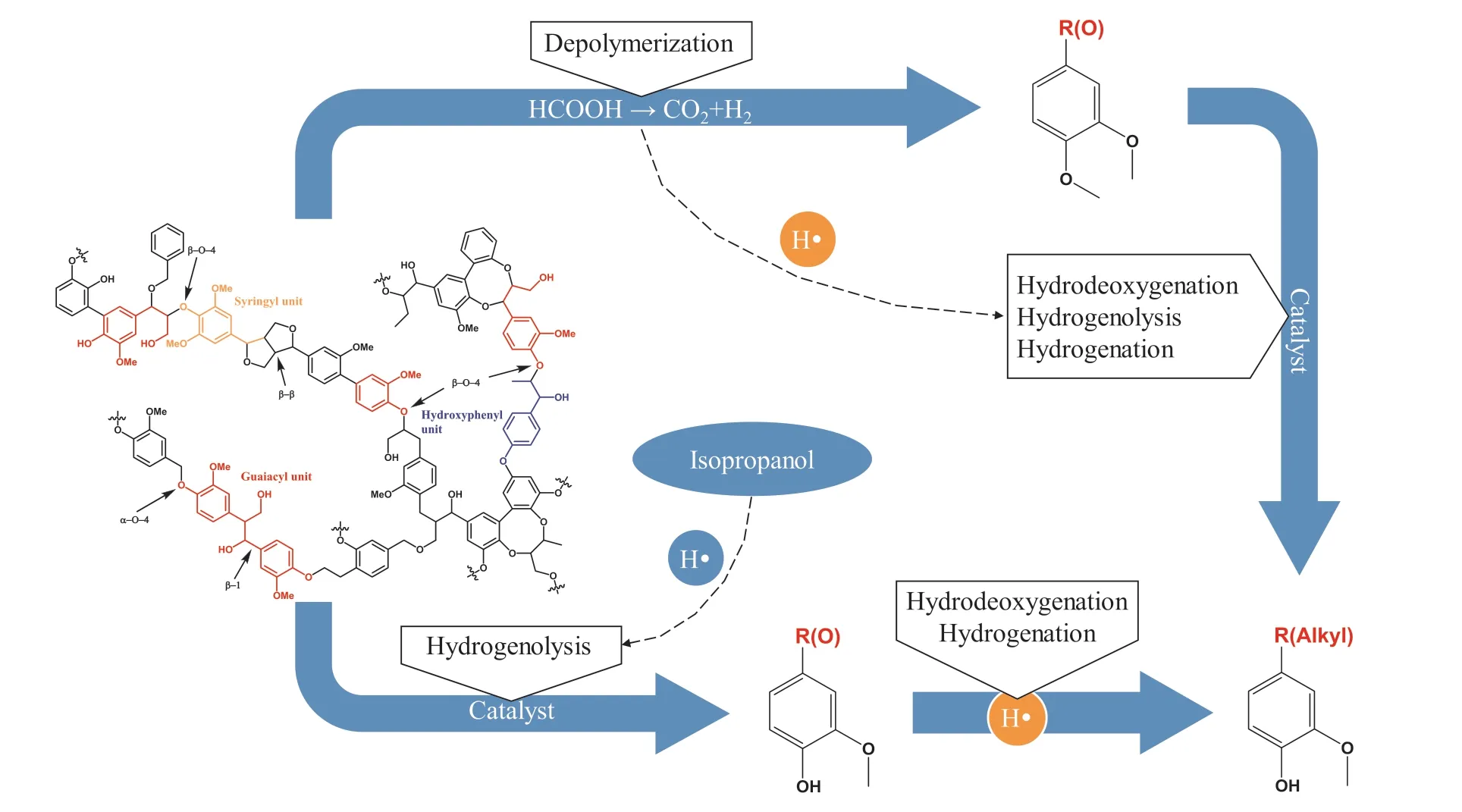
Fig.1.Possible reaction mechanism of lignin depolymerization.
2.3.Catalyst characterization
Brunauer-Emmett-Teller (BET) surface area,pore volume and pore size of prepared catalysts were measured by N2-physisorption measurement conducted at -196 °C on an ASAP 2020 instrument (Micromeritics,USA).X-ray diffraction (XRD)was conducted in a 2-theta range of 20°-80° at the scanning rate of 10(°)·min-1by MiniFlex 600 using Cu Kα(λ=0.15406 nm)irradiation (Rigaku,Japan).Scanning electron microscopy (Tecnai G2 F30,FEI,Netherlands) -energy dispersive X-ray spectroscopy(SEM-EDX) was applied to determine morphologies and surface elements of catalysts.Besides,the structure of catalysts was further investigated by high resolution transmission electron microscopy (HRTEM,JEM-2100 UHR,JEOL,Japan).
2.4.Catalytic evaluation
Lignin depolymerization was carried out in a stainless steel reactor (100 ml) with a magnetic stirrer.Typically,1 g of lignin and 0.2 g of catalyst were added into the reactor,50 ml of isopropanol and 5 ml of FA were subsequently mixed with the solid substrate.After checking leaks and removing air by purging highpurify nitrogen several times,the sealed reactor was heated up to target temperatures (180-240 °C) for 8 h with a fixed heating rate of 10 °C·min-1.At the end of reaction,the reactor was quenched with ice water.
2.5.Separation of depolymerized products
Depolymerized products included gas (non-condensed gases),liquid (organic monomers and oligomers) and solid (catalyst,char and unreacted lignin).Separation steps are shown in Fig.2.Because the mass of gaseous products was less than 5 mg(≤1%,mass fraction,as for lignin input),which were not taken into account in the next discussion.First,liquid and solid phases were obtained by washing reactor by DCM (3 × 30 ml) and separated by filtration with a pre-weighted filter membrane (0.45 g).Subsequently,solid products obtained were washed by DCM (3 × 10 ml) and the filtrate was merged into liquid phase.Besides,unreacted lignin was obtained by dissolving solid products with NaOH solution(3×50 ml,0.25 mol·L-1),and then collected by acidified precipitation with HCl(0.1 mol·L-1)until pH <2.Furthermore,the obtained unreacted lignin was filtered and washed with deionized water for three times until neutral,and then dried at 105 °C overnight.The remaining solid products (catalyst and char) were dried at 105 °C overnight for recyclability.Liquid phase was evaporated at 55 °C by a rotary evaporator to remove solvent and DCM to obtain biooil (dark-brown liquid with high viscosity).
2.6.Products analysis and characterization
The mass content of carbon,hydrogen and nitrogen in alkali lignin and unreacted lignin was conducted in CHN mode with a Vario EL III (Elementar,Germany) by using helium as carrier gas.The mass content of oxygen was calculated by difference.
Fourier transform infrared spectrometry (FTIR) was performed to investigate differences between raw lignin and unreacted lignin in terms of functional groups,which was carried out on an 870 Nexus FTIR spectrometer (Nicolet,USA).The range of detected wavenumber was 4000-500 cm-1and 32 scans per spectrum were collected with the resolution of 4 wavenumbers.
Gas chromatography-mass spectrometer (GC-MS,Agilent 7890A,USA),equipped with a HP-5 MS capillary column(30 m×0.25 mm×0.25 μm)was applied to figure out the composition of bio-oils.At the beginning of this analysis,oil samples were dissolved in ethanol (HPLC) to form the solution with concentration of 50 mg·ml-1,of which the injection volume was 1 μl.Temperature program inside was as follow: starting temperature was 50 °C and hold for 1 min.Subsequently,the increase in temperature with two different heating rates was operated,among which the first heating rate was 8°C·min-1kept for 1 min until the internal temperature reached 220 °C,and the second one was 10 °-C·min-1maintained for 1 min to rise temperature to 300 °C.Finally,identification of depolymerized products was based on the NIST library,and the yield of products was recorded as relative content(%) calculated by normalization of peak areas.The quantitative analysis of these chemicals was determined by internal standard calibration method using syringol as an internal standard compound.
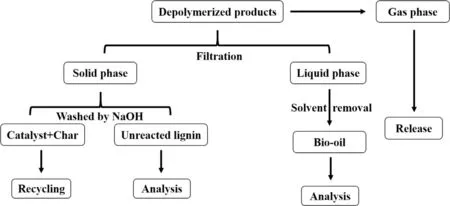
Fig.2.Separation steps of depolymerized products.
Yields(mass)of gas,solid(char),oil,and unreacted lignin were calculated by Eqs.(1)-(6),respectively [37,38].

wheremdifferenceis the difference in mass of reactor before and after reaction;mCO2is theoretical yield of CO2produced by FA decomposition;mligninis original mass of alkali lignin;msolidis the mass of solid obtained at the end of reaction (including char,catalyst and unreacted lignin);mcatalystis the mass of catalyst;munreactedligninis the mass of unreacted lignin;mbio-oilis the mass of liquid products after removing solvent and DCM;Wiis the mass of monomeridetermined by quantitative analysis.
3.Results and Discussion
3.1.Catalyst characterizations
3.1.1.BET
Table 2 shows that the surface area of ZrO2/WO3/γ-Al2O3support is 102 m2·g-1with pore volume of 0.41 cm3·g-1.With the increase of Ni loading from 0.4 to 1.2 mmol,the surface area decreases from 102 m2·g-1to 94 m2·g-1due to pore blockage,thus leading to a decline in pore volume(from 0.41 cm3·g-1to 0.33 cm3-·g-1) [39].However,a further increase in Ni loading (1.6 mmol)results in an increase in surface area,which might be due to the inhibition of crystal growth of ZrO2/WO3by Ni and the generation of pores between Ni particles and support,as well as the formation of Ni porous structure [34].For different combinations of ZrO2,WO3and Al2O3,different surface areas can be obtained.Higher content of metal oxide leads to lower surface area (94 m2·g-1for Ni1.2-ZrO2/WO3/γ-Al2O3,110 m2·g-1for Ni1.2-ZrO2/γ-Al2O3,and 121 m2·g-1for Ni1.2-WO3/γ-Al2O3),which is due to sintering and aggregation of oxide particles or the blocking effect in pore structure of γ-Al2O3[40].

Table 2 Physicochemical properties of synthesized support and catalysts
3.1.2.XRD
As shown in Fig.3(a),all samples present three main diffraction peaks of γ-Al2O3at 37.6°,46.0° and 66.7° (JCPDS card No.01-080-1385) [41],while peaks for monoclinic WO3(JCPDS card No.43-1035) and ZrO2(JCPDS card No.37-1484) can be found after W/Zr species incorporation [42,43],indicating the completed preparation of modified support (ZrO2/WO3/γ-Al2O3).In addition,after Ni metal addition,peaks at 44.6°,51.9°,76.4° assigned to Ni metal (JCPDS card No.00-004-0850) and peaks at 37.5°,45.4°,66.3° and 67.1° ascribed to Ni-Al oxide (JCPDS card No.00-020-0777) can be observed in Fig.3(b) [34].With the increase of Ni addition,the peak intensity increases,which means the formation of monometallic Ni and Ni-Al alloy in synthesized catalysts.
3.1.3.SEM and TEM
From Fig.4(a),some nanosheets presenting irregular morphologies with average size of 100 nm can be observed.Although superposition of multilayer nanosheets has been discovered,some individual nanosheets which are partially transparent can also be found.Similar morphological characteristics of flake accumulation can be found in SEM images,see Fig.S1 (in Supplementary Material) and Fig.4,and EDX elemental mapping shows the presence of different metals (Al,Zr,W and Ni).Additionally,many pores can be found on the surface of nanosheets,of which pore size is approximately from 10 to 20 nm (see Fig.5(b)).From Fig.5(c),some distinguishable lattice fringes with spaces of 0.270,0.365 and 0.230 nm are related to the(1 0 1)planes of tetragonal zirconia and planer distance of (0 0 2) of WO3,and the (3 3 1) plane of γ-Al2O3,respectively [41,44,45].Compared to the characteristics of ZrO2/WO3/γ-Al2O3(e.g.,partially transparent nanosheets containing many pores and obvious lattice fringes of ZrO2and WO3),some clusters presented in Fig.5(d) with different morphological features(e.g.,opaque aggregation containing some black nanoparticles can be observed,indicating the formation of Ni particles.
3.2.Catalytic evaluation
3.2.1.Effects of ZrO2,WO3 and Ni on catalytic ability
From Fig.6(a),the catalytic activity of pure γ-Al2O3is poor due to the lowest oil yield obtained (only 4.2%) after the reaction,which is caused by the insufficient active sites on γ-Al2O3surface.The oil yield increases from 4.2% to~8% after the incorporation of other different oxides (ZrO2or WO3),demonstrating that the presence of more active sites derived from Zr or W oxides leads to the enhancement of lignin conversion.However,the lower yield of lignin conversion (46.2%) with higher yields of solid (29%) and unreacted lignin (53.8%) obtained over γ-Al2O3promoted by Zr and W species (ZrO2/WO3/γ-Al2O3) still indicates the inadequate lignin depolymerization.Compared with catalytic performance ofWO3(ZrO2)/Al2O3,the increasing catalytic performance derived from the co-existance of W and Zr species does promote the lignin depolymerization in terms of more depolymerized products produced (total yield from~4.4% to 9.7%),which are dominated by oxygenated (4.5%) and unsaturated compounds (2.9%),indicating the inefficiency of HDO and hydrogenation.With the addition of active metal Ni,dramatical decreases of solid and unreacted lignin lead to a significant increase in oil yield(40.1%),which indicates its excellent performance on lignin conversion (hydrogenolysis) and inhibition of char formation.Additionally,the decrease of oxygenated and unsaturated compounds yields result in a increase in the yield of G1,G2,G3,and G5(see Fig.6(c),the branch at position 4 is oxygen-free and saturated).Depolymerized product distribution shows the improved capability of HDO and hydrogenation derived from active Ni phase.
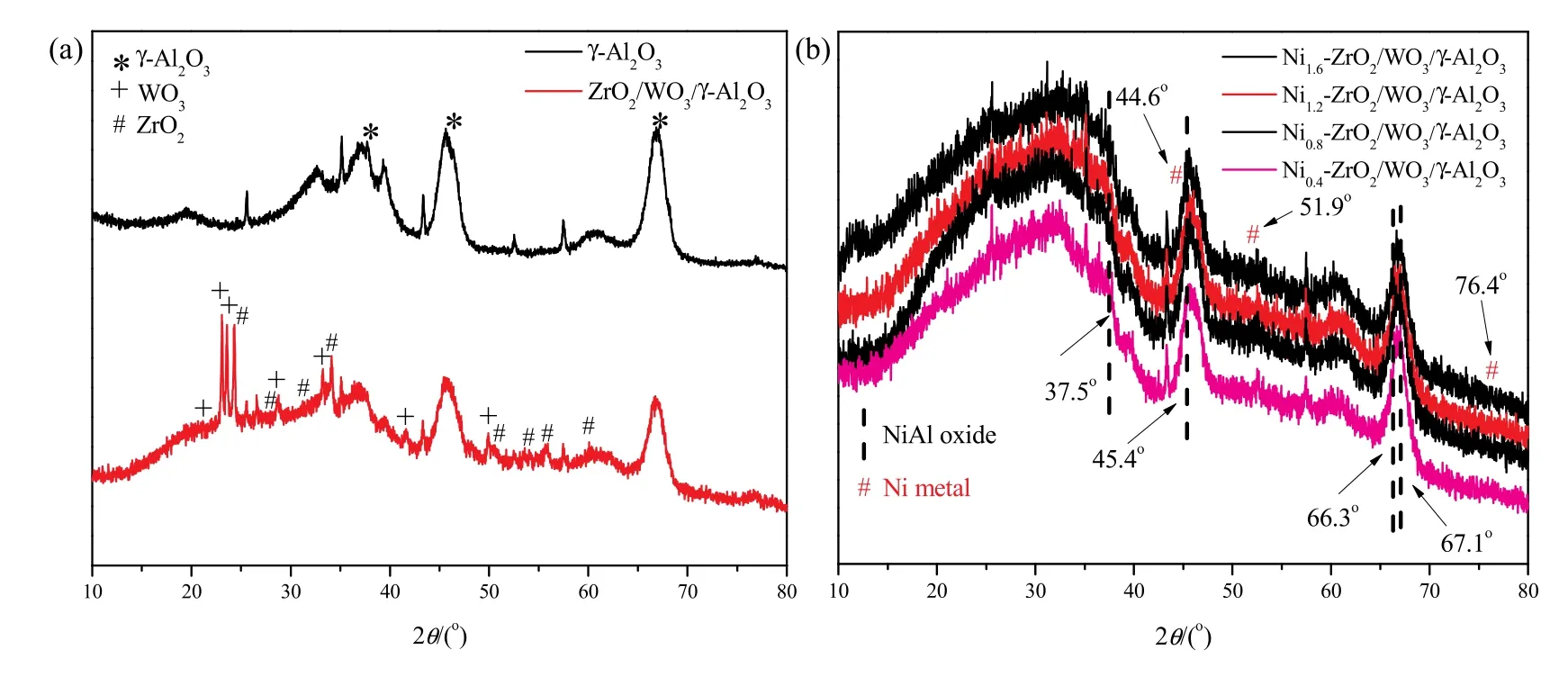
Fig.3.XRD patterns of (a)γ-Al2O3,ZrO2/WO3/γ-Al2O3 and (b) various Ni-based catalysts.
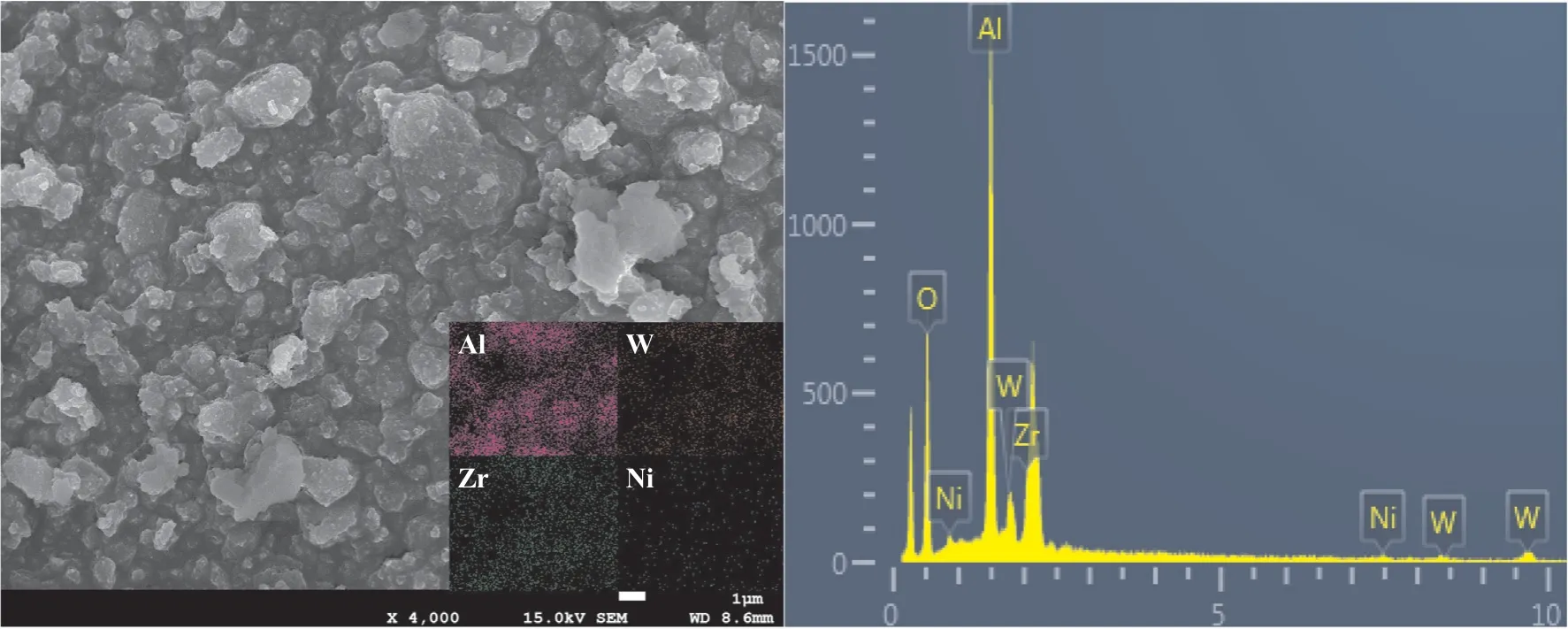
Fig.4.SEM-EDX analysis of Ni1.2-ZrO2/WO3/γ-Al2O3.
3.2.2.Effects of Ni loadings,reaction temperatures,FA and catalyst additions on lignin depolymerization
These experiments were performed for finding the optimizing conditions of lignin depolymeizarion and results were shown in Table S1.Patterns are presented in Fig.7,when Ni loading is 0.4 mmol,oil yield is relatively low at 34.1%,which increases slightly with the increase of Ni addition,which reaches the maximum value at 40.1% as Ni loading rises to 1.2 mmol (Fig.7(a)).Totonget al.[46]also drew the conclusion that increasing Ni loading resulted in an increase in lignin conversionviachanging the chemistry of active sites on catalyst to promote the breaking of C-O-C and C-C bonds.However,particle agglomeration will be caused by the further increasing metal loading,which will lead to a decrease in catalytic ability,resulting in a decrease in oil yield.
From Fig.7(b),oil yield is 24.7% at 180 °C,which increases to 40.1% at 240 °C,which means that lignin degradation is an endothermic process,which is enhanced significantly along with an increase in reaction temperature.A similar trend can be observed in solid yield,increasing by 2.28% from 180 to 240 °C.Bartaet al.[47] also reported that the higher solid yield can be obtained at high temperatures.Moreover,both solid and oil yields all reach their maximum at 240 °C,which demonstrates that increasing temperature is advantageous for lignin conversion as higher temperatures provides more heat to meet energy requirements of bond cleavage,yet it is adverse for inhibition of decomposition,condensation or repolymerization of lignin intermediates and depolymerized products,and char formation.
In the absence of both catalyst and FA,the yield of unreacted lignin is extremely high at 85.66%,and less than 20% of lignin has been transformed into oil or solid product (Fig.7(c)).With the addition of FA,the yield of unreacted lignin declines significantly from 85.7% to 28.5%,yet high yield of solid product(59.9%) still poses a threat to the production of bio-oil (10.9%).The possible reason is that as an acid catalyst,FA itself makes contributions to lignin depolymerization,yet acidic environment derived from FA also promotes the generation of solid product (i.e.char) [48,49].However,solid yield decreases significantly from 59.9% to 20.3% with the further addition of Ni1.2-ZrO2/WO3/γ-Al2O3catalyst,indicating that the presence of prepared functional catalyst makes contributions to the inhibition of solid production(as described in Section 3.2.1).
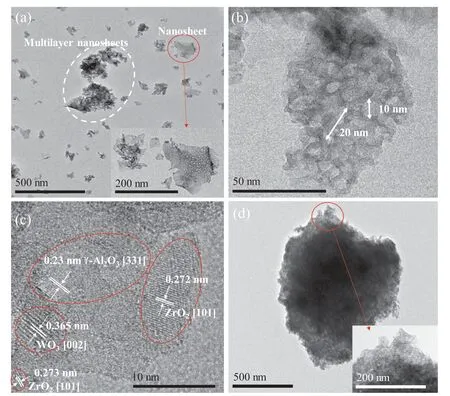
Fig.5.TEM images of (a)-(c) ZrO2/O3/γ-Al2O3 and (d) Ni1.2-ZrO2/WO3/γ-Al2O3.
3.2.3.Recyclability of catalyst on lignin depolymerization
Patterns in Fig.7(d)clearly show that the catalytic performance is gradually weakened with catalyst recycling,which is obviously reflected on a decline in oil yield (from 40.1% to 15.4%) and a rise in solid yield (from 20.3% to 53.7%).According to our previous study,there were some solid residues deposited on the catalyst surface,which undermined catalytic activities by covering active sites [50].
3.3.Depolymerized products analysis
According to the quantitative analysis of depolymerized products of lignin in Section 3.2.1,the effect of each component (Zr,W,and Ni) in catalyst was investigated comprehensively,which confirmed the excellent catalytic ability of prepared multicomponent functional catalyst (Ni1.2-ZrO2/WO3/Al2O3).However,the further study of changes in product distributionis also interesting and important for understanding the interconversion between depolymerized productsof lignin.From GC-MS analysis,the relative content (%) of each compound can be obtained.By recording changes in the relative content of all corresponding products,a clear observation of mutual conversion between obtained products can be captured,thus the reaction mechanism of lignin depolymerization can be proposed.
For GC-MS analysis,lignin derived bio-oils were all dissolved in ethanol (HPLC,≥99.8%) to obtain the alcohol extract.As given in Fig.S2,a total of 22 compounds can be obtained,including esters,ethers,ketones and phenols,wherein G-type phenols are the main products,and less than 2% of components are S-type (2,6-dimethoxyphenol) or H-type (catechol) phenols.Based on all phenolic compounds detected in bio-oils,14 different kinds of G-type phenols with different substituents are gained and investigated,namely G1-G14.Additionally,a small proportion (9.01%) of C6-C10compounds are also formed,such as (s)-isopropyl iactate,2-(1-propan-2-yloxyethoxy)-propane,succinic acid diisopropyl ester and 1,1-diethoxyacetone,which are mainly attributed to oxidation,esterification,dehydration,and aldol condensation between solvent molecules and FA [51].
From Fig.8(a),the relative content of oxygen-containing guaiacols (e.g.,G10-G14) is relatively high (45.21%) at 0.4 mmol of Ni loading,and then decreases to 31.08% when Ni loading increases to 1.2 mmol.The opposite trend can be found in alkyl guaiacols,where a significant increase in the relative content of saturated alkyl guaiacols can be observed,reaching the maximum value at 53.37% when Ni loading is 1.2 mmol.Moreover,the percentage of G2 increases markedly from 16.88%to 24.14%as Ni loading rises from 0.4 to 1.2 mmol,and then declines to 8.89%as Ni loading further climbs to 1.6 mmol.Similar variations can also be observed in G1,G3,G4,G5 and G7.It suggests that HDO and hydrogenation have proceeded with more Ni loading,which is beneficial for the production of alkyl guaiacols.However,the excessive Ni loading(1.6 mmol) will cause an adverse effect on catalytic activities of catalyst,which leads to Ni particle agglomeration,resulting in inadequate HDO and hydrogenation reactions.
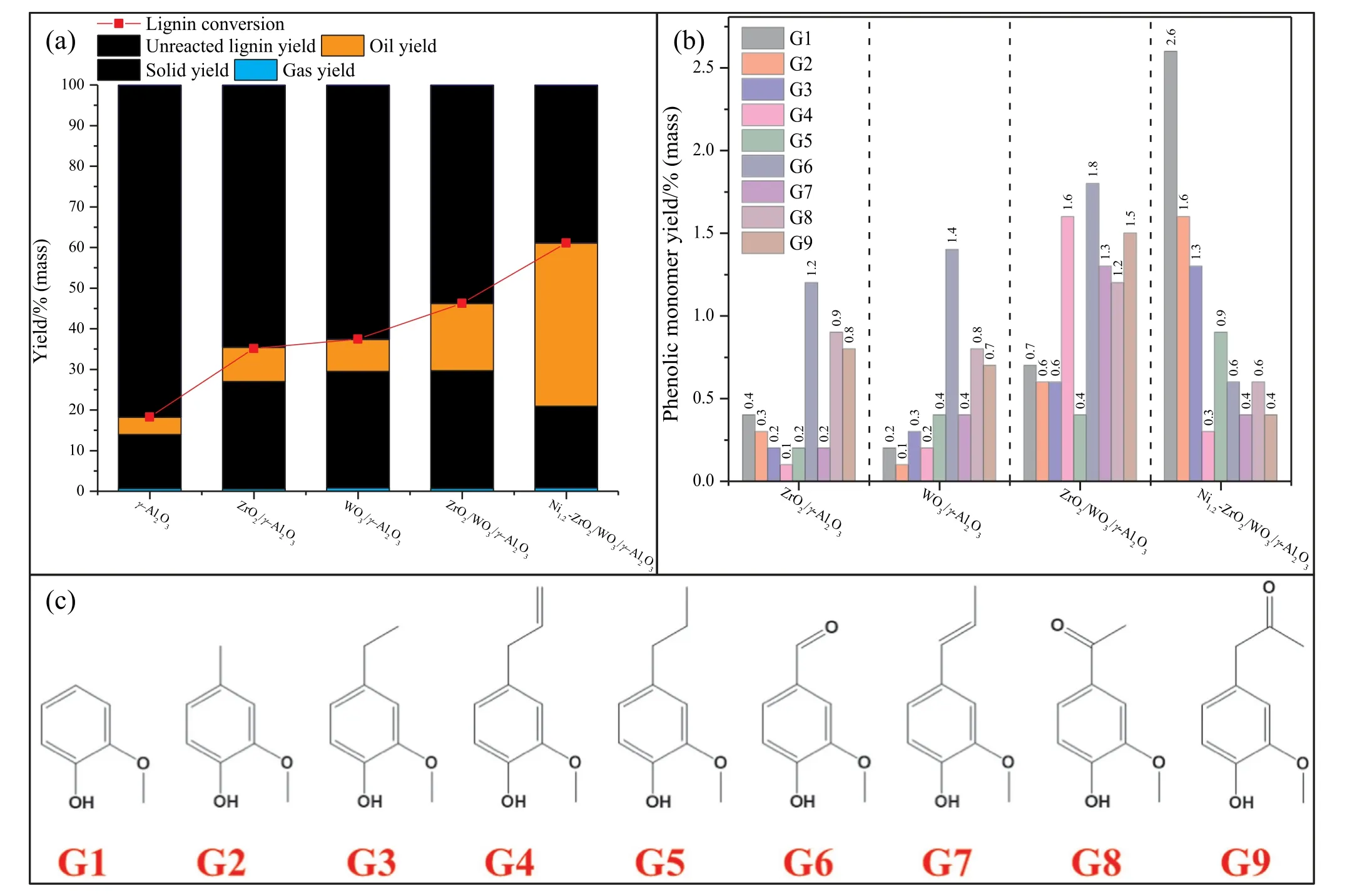
Fig.6.(a) Catalytic evaluation of different catalysts,including pure γ-Al2O3,ZrO2/γ-Al2O3,WO3/γ-Al2O3,ZrO2/WO3/γ-Al2O3,and Ni1.2-ZrO2/WO3/γ-Al2O3.(b) Quantitative analysis of main phenolic compounds in bio-oils obtained over different catalysts.(c) Chemical structures of main phenolic compounds.
Konget al.[11]found that the reaction temperature has a significant effect on product distribution.From Fig.8(b),when the reaction temperature increases from 180 to 240°C,the relative content of alkyl guaiacols(e.g.,G1-G5,G7,and G11)grows from 12.45%to 66.67% (wherein the increasing rate of G2 is fastest,reaching its maximum value at 240°C),while that of oxygen-containing guaiacols declines quickly from 87.56%to 31.08%.It is worth noting that the proportion of unsaturated alkyl guaiacols shows a growing trend as the temperature increases,which indicates the promoted HDO reaction,while the effect of hydrogenation declines with the growth of temperature.Moreover,it is obvious that the selectivity of Ni1.2-ZrO2/WO3/γ-Al2O3to phenolic products is high (approximately 90% in total),wherein the main component is vanillin,which accounts for 65.65% at 180 °C.
In the absence of both catalyst and FA (i.e.,NON),the relative content of oxygen-containing guaiacols is relatively high(52.63%),while that of alkyl guaiacols is 44.46%(see Fig.8(c)).With the addition of catalyst (CA),the percentage of oxygen-containing guaiacols deceases,while that of alkyl guaiacols increases,which is mainly reflected in an increase in the proportion of unsaturated alkyl guaiacols from 1.84%to 17.26%.Interestingly,G-type phenols obtained at FA (only formic acid added) are all oxygen-containing guaiacols (100%) without any HDO reaction.Moreover,there are some compounds,such as (3,4-dimethoxyphenyl)-methanol,3,4-dimethoxyacetophenone,3-ethoxy-4-methoxybenzaldehyde and 3,4-dimethoxyphenethyl alcohol,which are produced by insufficient hydrogenolysis (see Fig.S2-FA).Above results show that the function of FA is to produce hydrogen for promoting lignin depolymerization guided by the catalyst Ni-ZrO2/WO3/γ-Al2O3,of which the effect is to introduce hydrogen more effectively to complete HDO,hydrogenolysis and hydrogenation.
To explore the recyclability of Ni1.2-ZrO2/WO3/γ-Al2O3catalyst,recycling experiments were conducted at 240 °C for 8 h assisted 5 ml FA in isopropanol.Patterns presented in Fig.8(d) illustrate that the proportion of alkyl guaiacols declines significantly from 66.82% to 51.17%,especially for that of saturated alkyl guaiacols,decreasing from 53.37% to 37.83%,while that of oxygencontaining guaiacols increases by 13.95% after three recycles.For example,the percentage of G1,G2 and G3 all decreases remarkably,while for G12 and G13,a stable increase in their proportion can be observed with catalyst recycling.It demonstrates that the catalytic activity of Ni-ZrO2/WO3/γ-Al2O3catalyst decreases due to catalyst deactivation caused by oxygen existing in reactor and acidic environment provided by FA.However,the spent catalyst still exhibits good selectivity to alkyl guaiacols (e.g.,G1,G2,G3,G5 and G7),although some oxygen-containing guaiacols (e.g.,G13 and G14) are prone to be generated with an increase in recycle.
3.4.Analysis of unreacted lignin
3.4.1.FTIR
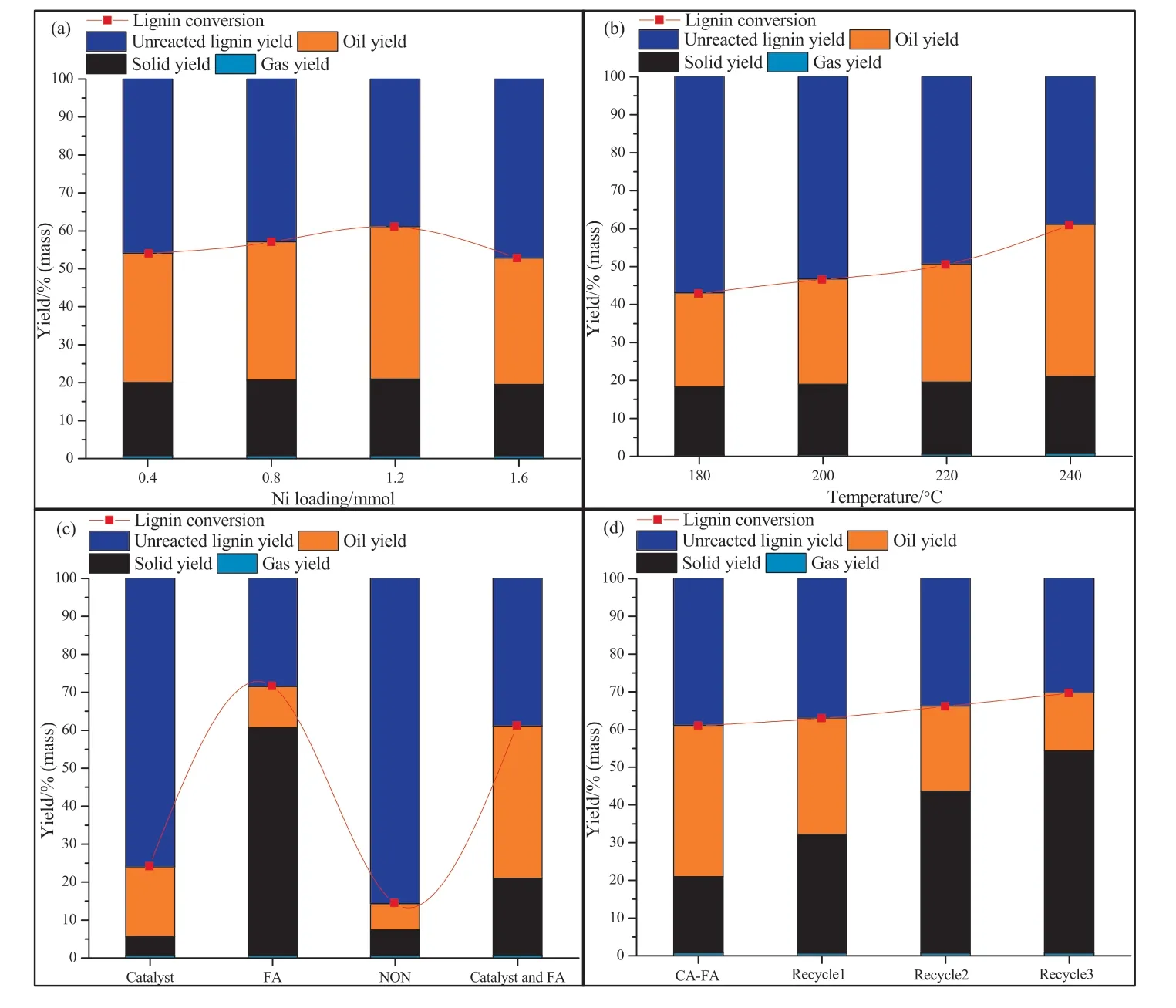
Fig.7.Effects of Ni loading(a),reaction temperature(b),FA and catalyst addition(c),and catalyst recycling(d)on lignin depolymerization.CA:only 0.2 g of Ni1.2-ZrO2/WO3/γ-Al2O3 added;FA:only 5 ml of formic acid added;NON:no catalyst and no formic acid added;CA-FA:both 0.2 g of Ni1.2-ZrO2/WO3/γ-Al2O3 and 5 ml of formic acid added.
FTIR spectra and data are presented in Fig.S3 and Table S2,respectively,of which wavenumbers are assigned according to the literature[24,52,53].The broad adsorption peak at the range of 3600-3200 cm-1is assigned to the stretching of O-H group.Peaks at 2943 and 2841 cm-1are attributed to the C-H vibration of methyl and methylene groups,respectively.Stretching vibrations at 1593,1511,1454 and 772 cm-1(out-of-plane) originate from aromatic rings.Besides,the symmetric C-H deformation of methoxy groups is observed at 1360 cm-1.Finally,bands at 1267,1215,1138,1035 and 877 cm-1are related to the stretching of C-O bands in guaiacyl and syringyl units.
From Fig.S3(a),the decrease in the absorbance of several functional groups of unreacted lignin can be observed as compared with the raw lignin.There is a significant decrease of O-H stretching at 3440 cm-1when the catalysts Nix-ZrO2/WO3/γ-Al2O3(x:0.4-1.6) are introduced into the reaction.The intensity of bands,especially at 1267,1215 cm-1(C-O stretching of guaiacyl and syringyl structures)and 1035 cm-1(aromatic C-H in-plane deformation for guaiacyl units) are all declined,which indicates that the raw alkali lignin is depolymerized into mono-aromatic units effectively.Additionally,a decrease in the band of aromatic rings at 1511 cm-1also demonstrates that the lignin is converted into monomer products.Similarly,increasing temperature causes a decrease in the absorbance of O-H band(see Fig.S3(b)).However,the intensity of C-H vibration of methylene at 2841 cm-1increases with the increase of temperature,which means that more methylene groups can be generated after the depolymerization reaction,especially at 240 °C.From Fig.S3(c),the efficient depolymerization can be obtained at CA-FA corresponding to a significant decrease in absorbance of bands at 3440 cm-1(O-H stretching),1511 cm-1(aromatic skeletal vibration),1267 and 1215 cm-1(C-O stretching of guaiacyl and syringyl structures),and an increase at 2841 cm-1(C-H vibration of methylene) as compared to other lignin samples (obtained from NON,FA,and CA).Fig.S3(d)shows that the catalyst Ni1.2-ZrO2/WO3/γ-Al2O3still retains a certain catalytic activity with the increase of catalyst recycling,reflected on a decrease in signal peaks at 1511 cm-1(aromatic skeletal vibration),1267,1215 cm-1(C-O stretching of guaiacyl and syringyl structures) and 1035 cm-1(aromatic C-H in-plane deformation for guaiacyl units) as compared to the raw lignin.
3.4.2.Elemental analysis
Variations in H/C and O/C ratio of unreacted lignin obtained after lignin depolymerization reaction are shown in Figs.S4(a-d).Compared with the raw alkali lignin,O/C and H/C ratio of unreacted lignin all change significantly,which indicates that the elemental composition of raw alkali lignin is changed as lignin depolymerization proceeds.Possible reasons are the decrease in the number of benzene rings (i.e.,the production of bio-oil),the condensation of lignin fragments (i.e.,the formation of char),and the shedding of functional groups from lignin (e.g.,O-H,C-H of methyl and methylene).With the increase of Ni loading (from 0.4 to 1.6 mmol),the value of H/C ratio decreases dramatically to approximately 0.03,while that of O/C ratio increases to approximately 0.84(the higher O/C ratio,the lower C content in unreacted lignin).Moreover,the maximum value of O/C ratio appears as Ni loading is 1.2 mmol,corresponding to the maximum yield of biooils obtained at this condition,which demonstrates that more carbon on aromatic rings or side chains exists in the form of bio-oil.In addition,increasing temperature (from 180 to 240 °C) is also important for exhibiting differences in H/C and O/C ratio between the raw alkali lignin and unreacted lignin.The higher value of O/C ratio of unreacted lignin can be obtained at higher temperatures,which means the carbon transfer from alkali lignin to bio-oils can be achieved more efficiently with the increase of temperature.Besides,different controlling factors (i.e.,CA,FA and NON) show different effects on H/C and O/C ratio,wherein the maximum value of O/C ratio (0.97) can be obtained at FA.Although the slight decrease occurs after the addition of catalyst (CA-FA),the higher yield of bio-oil gained at this condition means the better carbon utilization.Finally,the unreacted lignin generated at three recycling experiments is also the measuring subject of H/C and O/C ratio,and the result shows that O/C ratio decreases gradually with an increase in catalyst recycling,which is related to the lower oil yield due to the worse catalytic performance caused by the catalyst deactivation.
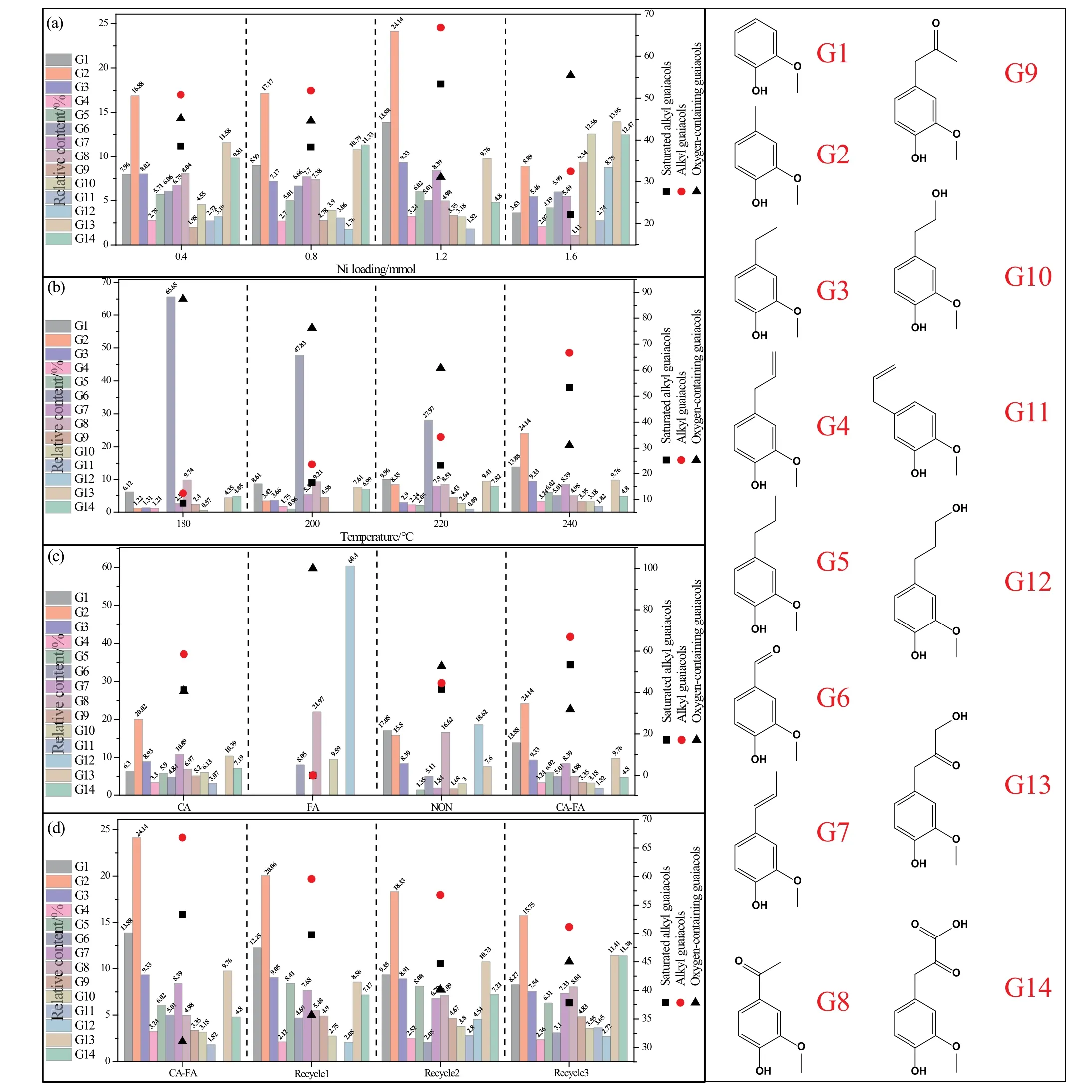
Fig.8.Effects of(a)Ni loadings,(b)reaction temperatures,(c)FA and catalyst additions,and(d)catalyst recycling on product distribution determined by the relative content from GC-MS.
4.Conclusions
The catalyst Nix-ZrO2/WO3/γ-Al2O3(x: 0.4-1.6) prepared by chemical reduction method using NaBH4as a reducing agent showed high dispersion of Ni and was utilized for the catalytic depolymerization of alkali lignin into phenolic compounds.The best catalytic performance in product upgrading was obtained at Ni1.2-ZrO2/WO3/γ-Al2O3.Effects of Ni loadings (from 0.4 to 1.2 mmol),reaction temperatures(from 180 to 240°C),FA and catalyst additions,and catalyst recycling on lignin depolymerization were all explored in this study for obtaining the optimal conditions of lignin conversion.Quantitative analysis showed that the excellent performance of this prepared functional multi-component catalyst was derived from each component (ZrO2,WO3,and Ni).Internal reaction mechanism was determined by GC-MS and results illustrated that phenols were main products,wherein guaiaciol and its derivatives were main components.Higher temperatures were more prone to produce alkyl guaiacols during lignin depolymerization.The analysis of unreacted lignin (FTIR and elemental analysis)further confirmed that alkali lignin was converted into bio-oils efficiently.
Declaration of Competing Interest
The authors declare that they have no known competing financial interests or personal relationships that could have appeared to influence the work reported in this paper.
Acknowledgements
This research was financially supported by the National Natural Science Foundation of China (21774059),the Priority Academic Program Development (PAPD) of Jiangsu Higher Education Institutions.
Supplementary Material
Supplementary data to this article can be found online at https://doi.org/10.1016/j.cjche.2021.07.018.
 Chinese Journal of Chemical Engineering2022年8期
Chinese Journal of Chemical Engineering2022年8期
- Chinese Journal of Chemical Engineering的其它文章
- Notes for Contributors
- Preparation and functional study of pH-sensitive amorphous calcium phosphate nanocarriers
- Crystallization thermodynamics of 2,4(5)-dinitroimidazole in eleven pure solvents
- Chiral LVFFARK enantioselectively inhibits amyloid-β protein fibrillogenesis
- An international comprehensive benchmarking analysis of synthetic biology in China from 2015 to 2020
- Research on prediction model of formation temperature of ammonium bisulfate in air preheater of coal-fired power plant
